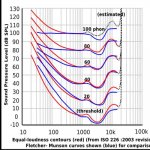Originally there had been some discussion both on the board, some emails, and some bbq side chat about how running full rangers sealed with a helper woofer.
Now it seems our good friends at http://www.vonschweikert.com/unifield3.htm seem to have thought along the same lines when designing their $15,000 Unifield 3.
With my back log of projects, looking for a house, and raising a toddler the timeline on this project can be considered "long", but thought it made for a great discussion.
and a way to build a speaker (by my estimate) that retails for 17.6 times the raw driver costs.
Looking at the just published images of the http://www.vonschweikert.com/unifield3.htm
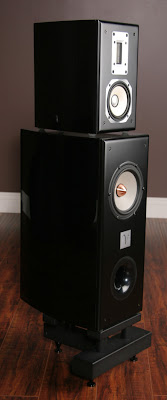
zoom in on the top "time aligned box"
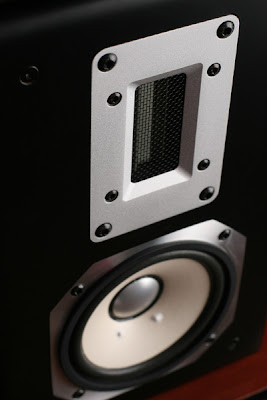
the tweeter looks remarkably like the fountek neo
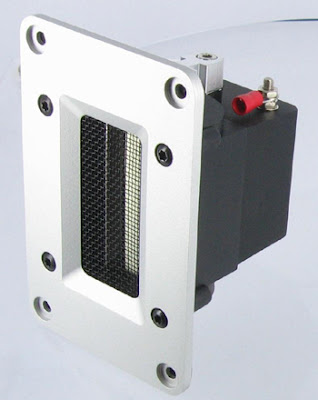
and our fostex fx120 fullranger
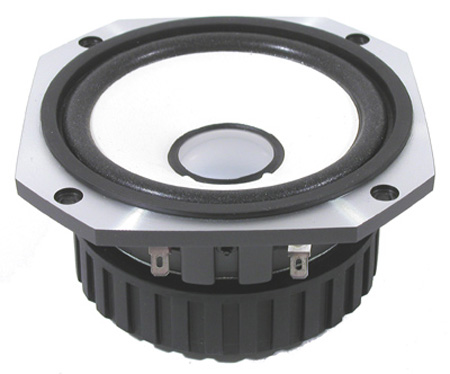
The woofer might be the seas excel w22e
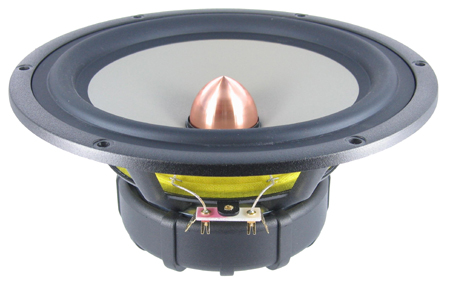
Grand total on the drivers: 2*(89 + 232 + 102) = $846
So, to get the conversation started... are there better woofer options? With the fx120 easily running to sub 20o Hz, why choose a woofer that doubles up on the fx120? I would think a rolling a woofer gently into the fx120 around 150 or 200 would be optimal. Pad the tweet down, and bringing it in ~4k (phase dependent) covers both dispersion and the high frequencies.
Thoughts? Opinions? Guinea pigs who are going to build and test it?
Now it seems our good friends at http://www.vonschweikert.com/unifield3.htm seem to have thought along the same lines when designing their $15,000 Unifield 3.
With my back log of projects, looking for a house, and raising a toddler the timeline on this project can be considered "long", but thought it made for a great discussion.
and a way to build a speaker (by my estimate) that retails for 17.6 times the raw driver costs.
Looking at the just published images of the http://www.vonschweikert.com/unifield3.htm

zoom in on the top "time aligned box"

the tweeter looks remarkably like the fountek neo

and our fostex fx120 fullranger

The woofer might be the seas excel w22e

Grand total on the drivers: 2*(89 + 232 + 102) = $846
So, to get the conversation started... are there better woofer options? With the fx120 easily running to sub 20o Hz, why choose a woofer that doubles up on the fx120? I would think a rolling a woofer gently into the fx120 around 150 or 200 would be optimal. Pad the tweet down, and bringing it in ~4k (phase dependent) covers both dispersion and the high frequencies.
Thoughts? Opinions? Guinea pigs who are going to build and test it?
Re: von schweikert unifield 3, an offshoot from "fullranger with helper woofer"
I already have a similar concept (acyally 2 of them) running.
FE127 (in Fonken) XOed to a pair of CSS SDX7 in an aperiodic TL. Actuvely XOed 2nd order at 100 Hz. I have popped a pr of Aurum Cantus on the top but not tried to dial in the XO. I have FX120 on the bench.
The other setup is a single SDX7 XOed to at FF85 (which is a tweeter in its own right) at 333 Hz.
dave
d to the g said:So, to get the conversation started... are there better woofer options? With the fx120 easily running to sub 20o Hz, why choose a woofer that doubles up on the fx120? I would think a rolling a woofer gently into the fx120 around 150 or 200 would be optimal. Pad the tweet down, and bringing it in ~4k (phase dependent) covers both dispersion and the high frequencies.
I already have a similar concept (acyally 2 of them) running.
FE127 (in Fonken) XOed to a pair of CSS SDX7 in an aperiodic TL. Actuvely XOed 2nd order at 100 Hz. I have popped a pr of Aurum Cantus on the top but not tried to dial in the XO. I have FX120 on the bench.
The other setup is a single SDX7 XOed to at FF85 (which is a tweeter in its own right) at 333 Hz.
dave
Re: von schweikert unifield 3, an offshoot from "fullranger with helper woofer"
Depends on your crossover points, slopes & what dynamic range you're hoping to achieve. Sub 200Hz is usually preferable from the POV of XO audibilty or lack thereof (we're generalising of course). But, for e.g., let us say, you're designing the speaker primarily for use on orchestral music at high SPLs in a large room. The FX is unlikely to have sufficient excursion to handle the sub-500Hz transient swings & power requirements. So if that's your goal, then you can run a larger bass driver up further to take care of them, insofar as it (usually) has greater power handling & excursion. There's no right or wrong answer really; we're back to what the design goals are, and which compromises you're willing to accept in order to attain them.
d to the g said:So, to get the conversation started... are there better woofer options? With the fx120 easily running to sub 20o Hz, why choose a woofer that doubles up on the fx120? I would think a rolling a woofer gently into the fx120 around 150 or 200 would be optimal. Pad the tweet down, and bringing it in ~4k (phase dependent) covers both dispersion and the high frequencies.
Depends on your crossover points, slopes & what dynamic range you're hoping to achieve. Sub 200Hz is usually preferable from the POV of XO audibilty or lack thereof (we're generalising of course). But, for e.g., let us say, you're designing the speaker primarily for use on orchestral music at high SPLs in a large room. The FX is unlikely to have sufficient excursion to handle the sub-500Hz transient swings & power requirements. So if that's your goal, then you can run a larger bass driver up further to take care of them, insofar as it (usually) has greater power handling & excursion. There's no right or wrong answer really; we're back to what the design goals are, and which compromises you're willing to accept in order to attain them.
The cabinets they are using look identical to the pre-finished ones available from Parts Express. I have a curved 1ft³ cabinet in red cherry that looks exactly the same as the one in the pictures. The sizes and finishes they offer are also available through parts express....
From their website:
SPECIFICATIONS : UNIFIELD MODEL THREE
Frequency Range: 32Hz to 40kHz (-3dB down points are 25Hz to 50kHz).
Sensitivity: 88dB @ one watt/one meter in anechoic conditions, 91dB in-room.
Distortion: Less than 0.8% at normal listening level (5 watts).
Impedance: 8 Ohms nominal ( 4 Ohm minimum).
Dispersion Window: +/- 30 degrees horizontally at midrange/treble range.
Power Rating: 300 watts peak, 100-watts r.m.s. Minimum of 20 watts.
Connection: Bi-wire cables required, call for details on new VSA cables.
Available Finishes: High Gloss Piano Black or Cherry.
Weight: 190 lbs/pr including stands, woofer and midrange/tweeter modules.
Size: 40” (102cm) tall (on supplied stand) x 10” (25cm) wide x 14” (35cm) deep.
SPECIFICATIONS : UNIFIELD MODEL THREE
Frequency Range: 32Hz to 40kHz (-3dB down points are 25Hz to 50kHz).
Sensitivity: 88dB @ one watt/one meter in anechoic conditions, 91dB in-room.
Distortion: Less than 0.8% at normal listening level (5 watts).
Impedance: 8 Ohms nominal ( 4 Ohm minimum).
Dispersion Window: +/- 30 degrees horizontally at midrange/treble range.
Power Rating: 300 watts peak, 100-watts r.m.s. Minimum of 20 watts.
Connection: Bi-wire cables required, call for details on new VSA cables.
Available Finishes: High Gloss Piano Black or Cherry.
Weight: 190 lbs/pr including stands, woofer and midrange/tweeter modules.
Size: 40” (102cm) tall (on supplied stand) x 10” (25cm) wide x 14” (35cm) deep.
It's a wide-band midrange unit, like most FR drivers, so while it'll have decent treble on its own, 'decent' is not the same as 'excellent' & the Neo ribbon will likely be better & certainly have more HF extension, if you're bothered about stuff over 20Khz. Personally, I'm not a fan of ribbons matched to dynamic drivers, but if they've crossed up high enough (over ~8KHz), that shouldn't be too much of an issue. Again, ballpark figure, but it serves as a rough ROT.
As for the assumed Seas bass driver, looks exactly what you'd expect from them. Should be decent; nasty breakup mode high up, but that's far above the BW they're going to be using it in, so shouldn't be much of an issue assuming the XO design is competant. Personally, I'd prefer something substantially larger (as in a 15in woofer) with a good paper cone, but that's more a matter of taste. Probably a decent enough sonic match to the FX.
As for the assumed Seas bass driver, looks exactly what you'd expect from them. Should be decent; nasty breakup mode high up, but that's far above the BW they're going to be using it in, so shouldn't be much of an issue assuming the XO design is competant. Personally, I'd prefer something substantially larger (as in a 15in woofer) with a good paper cone, but that's more a matter of taste. Probably a decent enough sonic match to the FX.
FX120 Top End
hi,
well i'm pretty happy with the top end from the FX120.
Sound quite natural to me. And a crossover at rather high frequencies is not without it's own set of problems. The wavelength at 10KHz is only around 3.5 cm, so spacing between drivers could get a bit problematic.
But relieving it from low bass duties helps quite a bit...
Michael
hi,
well i'm pretty happy with the top end from the FX120.
Sound quite natural to me. And a crossover at rather high frequencies is not without it's own set of problems. The wavelength at 10KHz is only around 3.5 cm, so spacing between drivers could get a bit problematic.
But relieving it from low bass duties helps quite a bit...
Michael
high crossover: difficulty?
"And a crossover at rather high frequencies is not without it's own set of problems. The wavelength at 10KHz is only around 3.5 cm, so spacing between drivers could get a bit problematic."
I've seen a number of single driver types talk about rolling in a tweeter real high, and so I've wondered about this issue before. Is center to center spacing the sort of thing you have to worry about with real high crossed tweeters ~10 khz? I wonder if the wavelength might be getting short enough up there that you can't extract phase info from it anyway. You'd never get away with tweeters helping out the larger FR drivers if you had to sweat that.
May be a can of worms, thought I'd ask anyway.
edit: ah, scottmoose chimes in whilst I type...
"And a crossover at rather high frequencies is not without it's own set of problems. The wavelength at 10KHz is only around 3.5 cm, so spacing between drivers could get a bit problematic."
I've seen a number of single driver types talk about rolling in a tweeter real high, and so I've wondered about this issue before. Is center to center spacing the sort of thing you have to worry about with real high crossed tweeters ~10 khz? I wonder if the wavelength might be getting short enough up there that you can't extract phase info from it anyway. You'd never get away with tweeters helping out the larger FR drivers if you had to sweat that.
May be a can of worms, thought I'd ask anyway.
edit: ah, scottmoose chimes in whilst I type...
Well, if one takes a gander at the Fletcher-Munson / Equal Loundess curve, we see a rapid diminishing of our hearing accuity with rising frequency over about 8Khz or so, the most significant band being approx. 200Hz - 4KHz. So while nominally not perfect, within reason, you can get away with things that you couldn't in our acute hearing BW. Ditto for the LF.
Attachments
Well, i found out, that i like a small Fullrange driver, like the FX120, and a Woofer more than a large Fullranger and a Tweeter.
But i think it really comes down to personal preference.
Either way, you most likely don't have a crossover in the critical midrange...
Michael
But i think it really comes down to personal preference.
Either way, you most likely don't have a crossover in the critical midrange...
Michael
I'll be able to compare small full + helper woofer vs a large full + helper tweeter in the short term. A 126 with some 8" woofers from Jack Hidley vs a Pioneer B20 with Dayton tweeter. Hopefully that should give me a better idea of what I want to do for more ambitious projects in the future. I wish I could say more from experience, but for now I'll just sit back and learn.
So the cabinets appear by eyeball to be the .25cf on top, and the 1.0cf on bottom. Total of ~$450 for cabinets. Anyone have the cojones to walk in to a dealer with a tape measure? Cabinets weigh ~85lb so to meet specs drivers, crossovers, stands, and lead shot would be another ~105 Lbs. The web site says "Only the entry level speakers (this certainly would be one at "only" $15k\pr) are made in China". Specs may point to Seas W18E or W18EX woofer. The mid is said by some to be a "Ceramic compound" but yes, it looks identical to the Fostex FX-120. This looks like a very interesting project......
Bob G.
Bob G.
bobgroger said:The mid is said by some to be a "Ceramic compound" but yes, it looks identical to the Fostex FX-120.
It is a Fostex FX120. The coating that comes on the Kenaf cone could well be a paint on ceramic compound similar to what Totem uses on the inside of their boxes.
If one looks at the mid cabinets in the review of theBESL speaker in this months affordable audio, they also have the outward apperance of the rectamgular PE cabinet.
The PE cabinets do not satisfy the levels of performance i'd consider adequate for even a budget speaker. One could rework them, but it would be easier to start from scratch. the curved back cabinets are another matter.
dave
Hi,
Badge engineering or badge BS ? you decide ....
88dB/W .... 91DB in room ..... -3dB @ 25Hz
A lot easier to make up than actually build.
To work correctly with those sort of numbers would require bi-amping,
with a lot more juice on the bass end, ideally with active crossovers.
The "time aligment" is fairly meaningless at the bass/mid c/o point.
With the apparent drivers it would make an interesting project,
but a single amplifier passive system would be compromised.
The 25Hz - 3dB point is pure fantasy even at the bass units real
bass sensitivity of ~ 85dB in any sensible box, never mind the
somewhat restricted 1cuft bass section, a 8" needs more.
 /sreten.
/sreten.
Badge engineering or badge BS ? you decide ....
88dB/W .... 91DB in room ..... -3dB @ 25Hz
A lot easier to make up than actually build.
To work correctly with those sort of numbers would require bi-amping,
with a lot more juice on the bass end, ideally with active crossovers.
The "time aligment" is fairly meaningless at the bass/mid c/o point.
With the apparent drivers it would make an interesting project,
but a single amplifier passive system would be compromised.
The 25Hz - 3dB point is pure fantasy even at the bass units real
bass sensitivity of ~ 85dB in any sensible box, never mind the
somewhat restricted 1cuft bass section, a 8" needs more.
- Status
- This old topic is closed. If you want to reopen this topic, contact a moderator using the "Report Post" button.
- Home
- Loudspeakers
- Multi-Way
- von schweikert unifield 3, an offshoot from "fullranger with helper woofer"
